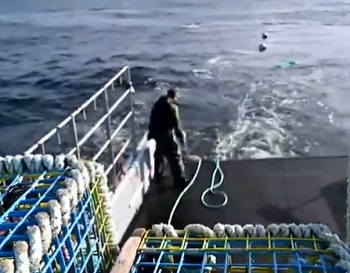Tag Archives: Nova Scotia lobster industry

Nova Scotia’s lobster industry faces massive setbacks due to Coronavirus impacts
It was shaping up to be one the best seasons ever, but then COVID-19 struck. Geoff Irvine says “it was probably the best time in the lobster industry ever.” As executive director of the Lobster Council of Canada, things were looking up as the new decade began. The shore price was good, catches were consistent and filled the demands of the markets for live and processed lobster. Then, along came COVID-19. Irvine says the Chinese market, the Atlantic industry’s biggest for live lobster, started to collapse on January 25th as they began closing restaurants in China. Europe and the United States would soon follow. Why can’t fishers just wait it out until demand rises again? It’s not that simple. >click to read< 11:28

Coronavirus: Nova Scotia lobster industry gets creative during pandemic to sell their catch
Lobster was Nova Scotia’s most valuable export in 2019, but this year, export markets have ground to a halt due to COVID-19. That has left the province’s lobster fisherman finding creative ways to sell their catch — with safety measures in place. “I’ve asked people to call ahead, so I can have their order ready. That way, I just take it to their vehicle and they open up their trunk and I just set it in their trunk,” said Bryce Hirtle, a fisherman on Nova Scotia’s south shore. 4 Videos, >click to read< 10:34
Nova Scotia lobster industry facing challenging season
 Seafood buyers are reporting high lobster mortality and poor quality, which a federal scientist says may be because lobsters are extra fragile this year in Canada’s largest lobster region off southwestern Nova Scotia. Fishermen are catching lobsters, bigger than ever, in “crazy, crazy numbers,” says Joel German, plant manager of I. Deveau Fisheries in Barrington Passage, but this winter, more than the usual amount have soft shells. “It’s not the same lobster as it used to be, so we can’t hold them as long,” he said. Lobsters generally grow out of and then shed their shells once a year in a process called moulting. As the shells grow back, they’re soft, making the lobster easier to hurt — and harder to store and ship. Read the rest here 09:58
Seafood buyers are reporting high lobster mortality and poor quality, which a federal scientist says may be because lobsters are extra fragile this year in Canada’s largest lobster region off southwestern Nova Scotia. Fishermen are catching lobsters, bigger than ever, in “crazy, crazy numbers,” says Joel German, plant manager of I. Deveau Fisheries in Barrington Passage, but this winter, more than the usual amount have soft shells. “It’s not the same lobster as it used to be, so we can’t hold them as long,” he said. Lobsters generally grow out of and then shed their shells once a year in a process called moulting. As the shells grow back, they’re soft, making the lobster easier to hurt — and harder to store and ship. Read the rest here 09:58
Green crab pathogen research raises concern for Nova Scotia lobster industry
 New research is raising more concerns about the potential transfer of diseases from the invasive green crab to lobster in Nova Scotia waters. “Our worry is there could be a pathogen transfer and it could damage our lobster industry. We are finding at least two pathogens of concern,” research scientist Fraser Clark says. He adds human health is not at risk. Clark released a study earlier this year showing high levels of a parasite in green crab is being found in areas of southern Nova Scotia where the crab has been introduced as a lobster bait. Read the rest here 08:50
New research is raising more concerns about the potential transfer of diseases from the invasive green crab to lobster in Nova Scotia waters. “Our worry is there could be a pathogen transfer and it could damage our lobster industry. We are finding at least two pathogens of concern,” research scientist Fraser Clark says. He adds human health is not at risk. Clark released a study earlier this year showing high levels of a parasite in green crab is being found in areas of southern Nova Scotia where the crab has been introduced as a lobster bait. Read the rest here 08:50
Nova Scotia lobster, or ‘Boston Lobster’ in China, could be rebranded
 With Canadian lobster sales in China at record levels, a major Nova Scotia exporter is trying rebrand the tasty crustacean to overcome its generic name in China: “Boston lobster.” “We all know Canadian lobster is better quality than lobster from the U.S. side,” says Jack Liu, of Zoneco, a large Chinese seafood company that has bought into the Nova Scotia lobster industry. “It’s stronger, the meat is fuller. The yield is high, there is more meat inside. “The first company in the Chinese market was American. “Boston lobster” has, as a result,,, Read the rest here 12:51
With Canadian lobster sales in China at record levels, a major Nova Scotia exporter is trying rebrand the tasty crustacean to overcome its generic name in China: “Boston lobster.” “We all know Canadian lobster is better quality than lobster from the U.S. side,” says Jack Liu, of Zoneco, a large Chinese seafood company that has bought into the Nova Scotia lobster industry. “It’s stronger, the meat is fuller. The yield is high, there is more meat inside. “The first company in the Chinese market was American. “Boston lobster” has, as a result,,, Read the rest here 12:51
EDITORIAL: Lobster levy flap foolish
 Nova Scotia Fisheries Minister Keith Colwell has been clawed up over the proposed penny-a-pound marketing levy on lobster landings. So it’s not surprising his federal counterpart, Gail Shea, wasn’t eager Monday to go to battle for an idea that many players in the Nova Scotia industry think is logical, but too few want to pay for. Read the rest here 09:19
Nova Scotia Fisheries Minister Keith Colwell has been clawed up over the proposed penny-a-pound marketing levy on lobster landings. So it’s not surprising his federal counterpart, Gail Shea, wasn’t eager Monday to go to battle for an idea that many players in the Nova Scotia industry think is logical, but too few want to pay for. Read the rest here 09:19
















































